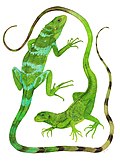| Ctenosaura melanosterna | |
|---|---|

| |
| Black-chested spiny-tailed iguana | |
| Conservation status | |
 Endangered (IUCN 3.1) | |
| CITES Appendix II (CITES) | |
| Scientific classification | |
| Domain: | Eukaryota |
| Kingdom: | Animalia |
| Phylum: | Chordata |
| Class: | Reptilia |
| Order: | Squamata |
| Suborder: | Iguania |
| Family: | Iguanidae |
| Genus: | Ctenosaura |
| Species: | C. melanosterna |
| Binomial name | |
| Ctenosaura melanosterna Buckley & Axtell, 1997 | |

| |
Ctenosaura melanosterna, commonly known as the black-chested spiny-tailed iguana or Honduran spinytailed iguana, is a species of iguana in the genus Ctenosaura. It is considered endangered.
General Background
Currently, the population trend of the Ctenosaura melanosterna is decreasing, with approximately 2,500-5,000 mature adults left. The overall total number of this species is unknown, but what we do know is that the mature population is decreasing and severely fragmented. This species has two range areas, Aguán Valley and Cayos Cochinos, with more of the subpopulation inhabiting the Valle de Aguán, but the density of the iguanas are so low that they are considered rare. The mainland where the Ctenosaura melanosterna are primarily located, Valle de Aguán, are rapidly decreasing due to exploitation and habitat destruction.
Life Span and Size
The typical life span of the Ctenosaura melanosterna, given the individual is healthy and dies from natural causes, is approximately 8 years.According to the International Iguana Foundation, male black-chested spiny-tailed iguanas in Cayos Cochinos average anywhere from 9.5-12.5 inches and weigh anywhere from 1.3-3.1 pounds. In the Valle de Aguán, males are approximately 2 inches shorter and usually weight around half the weight than individuals in Cayos Cochinos.
Geographic range
The black-chested spiny-tailed iguana is endemic to Honduras. It is only found in the Valle de Aguán in northern Honduras, and on the Cayos Cochinos archipelago off the Caribbean coast, mainly on the islands Cayo Mayor and Cayo Pequeño.
Habitat
The natural habitat of the black-chested spiny-tailed iguana is the scrubland and the dry forest. In the Valle de Aguán, the iguanas can be found inside forests mainly consisting of Acacia and cacti. However, in the Cayos Cochinos archipelago, the iguanas are usually found in open forest and on cliffs.
Diet
The iguanas are able to prey on smaller animals living in its habitat, such as arthropods, lizards, and fledglings. They are known to eat plant matter as well, such fruit and flowers.
Reproduction
Female black-chested spiny-tailed iguanas are oviparous animals, which mean that they reproduce by laying eggs.
Threats
There are a few reasons as to why the black-chested spiny-tailed iguana is endangered, but the most significant reason is human activity. Threats from humans include from hunting, trading, and habitat destruction and fragmentation. The forests in which the iguanas live are being cleared, mainly for agricultural purposes. The iguanas and their eggs are poached for human consumption as well. In addition, the Green iguana is also much more numerous throughout Central America, making it a competitor for food and resources.
Conservation Efforts
According to the IUCN, there is no actionary recovery plan, but there are efforts to provide a research and breeding station in the mainland on Honduras. Efforts to prevent further threats by illegal trade and over-harvesting to these iguana was to list them in CITES, which is the Convention on International Trade in Endangered Species of Wild Fauna and Flora.
References
- Pasachnik, S.; Montgomery, C.E.; Henningheim, E. (2012). "Ctenosaura melanosterna". IUCN Red List of Threatened Species. 2012: e.T44189A14857036. doi:10.2305/IUCN.UK.2012-1.RLTS.T44189A14857036.en. Retrieved 16 November 2021.
- "Appendices". cites.org. Retrieved 2022-01-14.
- ^ "Ctenosaura melanosterna". IUCN. February 19, 2024.
- ^ "CTENOSAURA MELANOSTERNA Black-chested Spiny-tailed Iguana".
- "Ctenosaura melanosterna". The Reptile Database. Retrieved 2024-04-29.
- Pasachnik, Stesha A.; Montgomery, Chad E.; Ruyle, Leslie E.; Corneal, Jeffrey P.; Antunez, Edoardo E. (31 December 2012). "Morphological and Demographic Analyses of the Blackchested Spiney-tailed Iguana, Ctenosaura melanosterna, Across Their Range: Implications for Population Level Management". Herpetogical Biology and Conservation. 7 (3): 399–406.
- Montgomery, Chad E., S. A. Pasaschnik, L. E. Ruyle, J. A. Frazier, and S. E. W. Green. 2014. Natural History of the Black-Chested Spiny-Tailed Iguanas, Ctenosaura melanosterna (Igunaidae), on Cayo Cochino Menor, Honduras. The Southwestern Naturalist 59:280–285.
Further reading
- Buckley, L.J., and R.W. Axtell. 1997. Evidence for the Specific Status of the Honduran Lizards Formerly Referred to Ctenosaura palearis (Reptilia: Squamata: Iguanidae). Copeia 1997 (1): 138–150.
- Montgomery, Chad E., S. A. Pasaschnik, L. E. Ruyle, J. A. Frazier, and S. E. W. Green. 2014. Natural History of the Black-Chested Spiny-Tailed Iguanas, Ctenosaura melanosterna (Igunaidae), on Cayo Cochino Menor, Honduras. The Southwestern Naturalist 59:280–285.
| Iguanidae | ||||||||||||||||||||||||
|---|---|---|---|---|---|---|---|---|---|---|---|---|---|---|---|---|---|---|---|---|---|---|---|---|
| ||||||||||||||||||||||||
| Taxon identifiers | |
|---|---|
| Ctenosaura melanosterna | |
This Iguanidae article is a stub. You can help Misplaced Pages by expanding it. |
